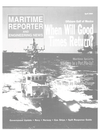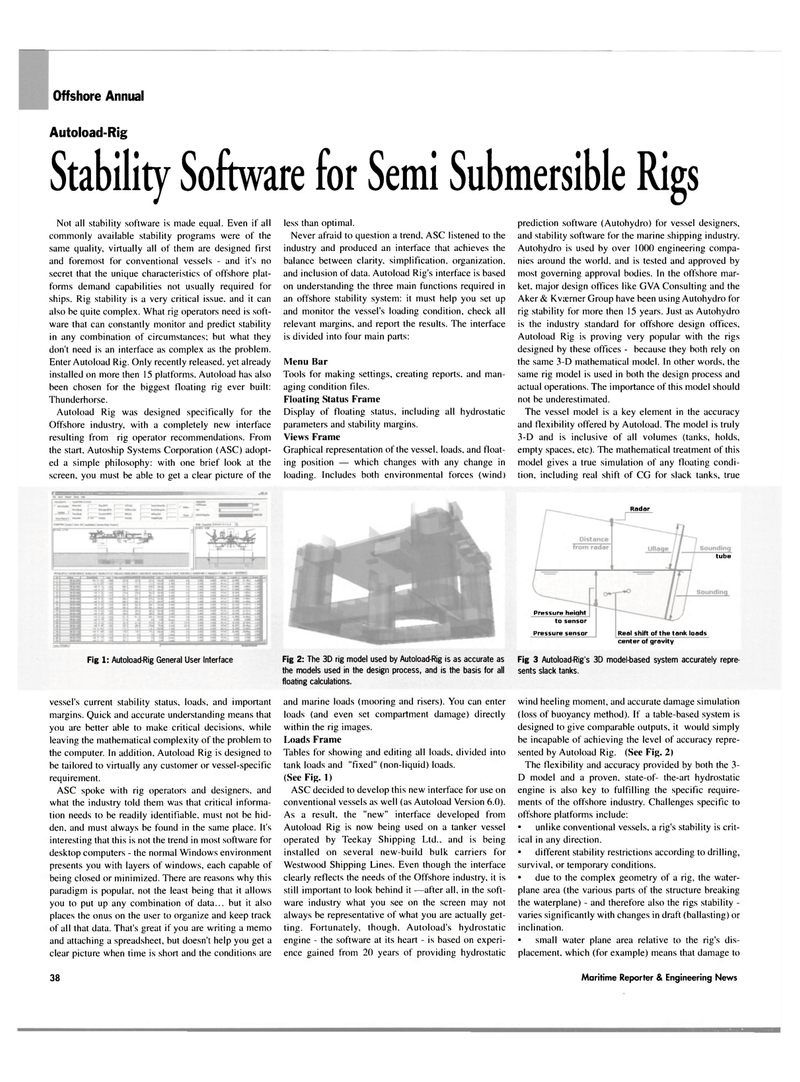
Page 40: of Maritime Reporter Magazine (April 2004)
Offshore Technology Yearbook
Read this page in Pdf, Flash or Html5 edition of April 2004 Maritime Reporter Magazine
Offshore Annual
Autoload-Rig
Stability Software for Semi Submersible Rigs
Not all stability software is made equal. Even if all commonly available stability programs were of the same quality, virtually all of them are designed first and foremost for conventional vessels - and it's no secret that the unique characteristics of offshore plat- forms demand capabilities not usually required for ships. Rig stability is a very critical issue, and it can also be quite complex. What rig operators need is soft- ware that can constantly monitor and predict stability in any combination of circumstances; but what they don't need is an interface as complex as the problem.
Enter Autoload Rig. Only recently released, yet already installed on more then 15 platforms. Autoload has also been chosen for the biggest floating rig ever built:
Thunderhorse.
Autoload Rig was designed specifically for the
Offshore industry, with a completely new interface resulting from rig operator recommendations. From the start, Autoship Systems Corporation (ASC) adopt- ed a simple philosophy: with one brief look at the screen, you must be able to get a clear picture of the less than optimal.
Never afraid to question a trend. ASC listened to the industry and produced an interface that achieves the balance between clarity, simplification, organization, and inclusion of data. Autoload Rig's interface is based on understanding the three main functions required in an offshore stability system: it must help you set up and monitor the vessel's loading condition, check all relevant margins, and report the results. The interface is divided into four main parts:
Menu Bar
Tools for making settings, creating reports, and man- aging condition files.
Floating Status Frame
Display of floating status, including all hydrostatic parameters and stability margins.
Views Frame
Graphical representation of the vessel, loads, and float- ing position — which changes with any change in loading. Includes both environmental forces (wind) prediction software (Autohydro) for vessel designers, and stability software for the marine shipping industry.
Autohydro is used by over 1000 engineering compa- nies around the world, and is tested and approved by most governing approval bodies. In the offshore mar- ket. major design offices like GVA Consulting and the
Aker & Kvaerner Group have been using Autohydro for rig stability for more then 15 years. Just as Autohydro is the industry standard for offshore design offices.
Autoload Rig is proving very popular with the rigs designed by these offices - because they both rely on the same 3-D mathematical model. In other words, the same rig model is used in both the design process and actual operations. The importance of this model should not be underestimated.
The vessel model is a key element in the accuracy and flexibility offered by Autoload. The model is truly 3-D and is inclusive of all volumes (tanks, holds, empty spaces, etc). The mathematical treatment of this model gives a true simulation of any floating condi- tion, including real shift of CG for slack tanks, true
Fig 2: The 3D rig model used by Autoload-Rig is as accurate as the models used in the design process, and is the basis for all floating calculations.
Fig 3 Autoload-Rig's 3D model-based system accurately repre- sents slack tanks.
Fig 1: Autoload-Rig General User Interface vessel's current stability status, loads, and important margins. Quick and accurate understanding means that you are better able to make critical decisions, while leaving the mathematical complexity of the problem to the computer. In addition. Autoload Rig is designed to be tailored to virtually any customer or vessel-specific requirement.
ASC spoke with rig operators and designers, and what the industry told them was that critical informa- tion needs to be readily identifiable, must not be hid- den, and must always be found in the same place. It's interesting that this is not the trend in most software for desktop computers - the normal Windows environment presents you with layers of windows, each capable of being closed or minimized. There are reasons why this paradigm is popular, not the least being that it allows you to put up any combination of data... but it also places the onus on the user to organize and keep track of all that data. That's great if you are writing a memo and attaching a spreadsheet, but doesn't help you get a clear picture when time is short and the conditions are and marine loads (mooring and risers). You can enter loads (and even set compartment damage) directly within the rig images.
Loads Frame
Tables for showing and editing all loads, divided into tank loads and "fixed" (non-liquid) loads. (See Fig. 1)
ASC decided to develop this new interface for use on conventional vessels as well (as Autoload Version 6.0).
As a result, the "new" interface developed from
Autoload Rig is now being used on a tanker vessel operated by Teekay Shipping Ltd., and is being installed on several new-build bulk carriers for
Westwood Shipping Lines. Even though the interface clearly reflects the needs of the Offshore industry, it is still important to look behind it —after all, in the soft- ware industry what you see on the screen may not always be representative of what you are actually get- ting. Fortunately, though, Autoload's hydrostatic engine - the software at its heart - is based on experi- ence gained from 20 years of providing hydrostatic wind heeling moment, and accurate damage simulation (loss of buoyancy method). If a table-based system is designed to give comparable outputs, it would simply be incapable of achieving the level of accuracy repre- sented by Autoload Rig. (See Fig. 2)
The flexibility and accuracy provided by both the 3-
D model and a proven, state-of- the-art hydrostatic engine is also key to fulfilling the specific require- ments of the offshore industry. Challenges specific to offshore platforms include: • unlike conventional vessels, a rig's stability is crit- ical in any direction. • different stability restrictions according to drilling, survival, or temporary conditions. • due to the complex geometry of a rig, the water- plane area (the various parts of the structure breaking the waterplane) - and therefore also the rigs stability - varies significantly with changes in draft (ballasting) or inclination. • small water plane area relative to the rig's dis- placement. which (for example) means that damage to center of gravity tube
Radar
Pressure height to sensor
Pressure sensor Real shift of the tank loads 38 Maritime Reporter & Engineering News

 39
39

 41
41
